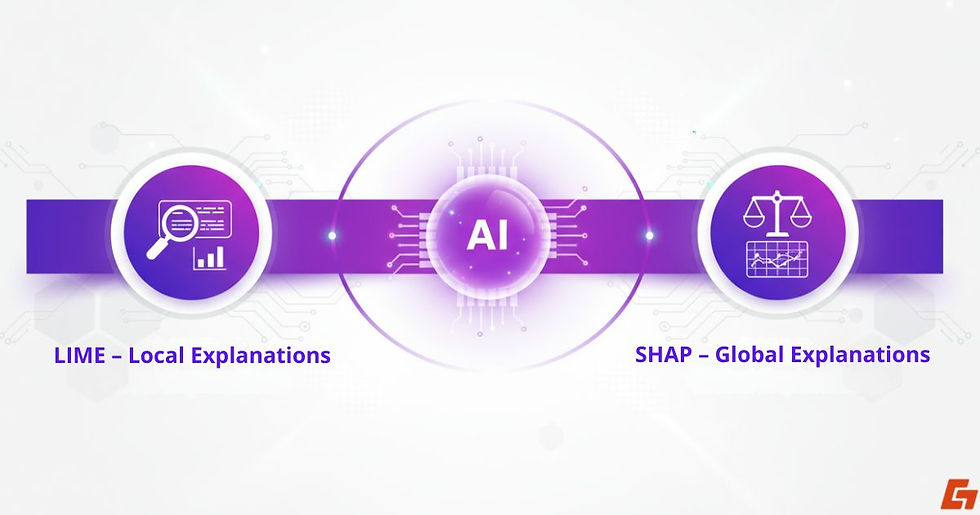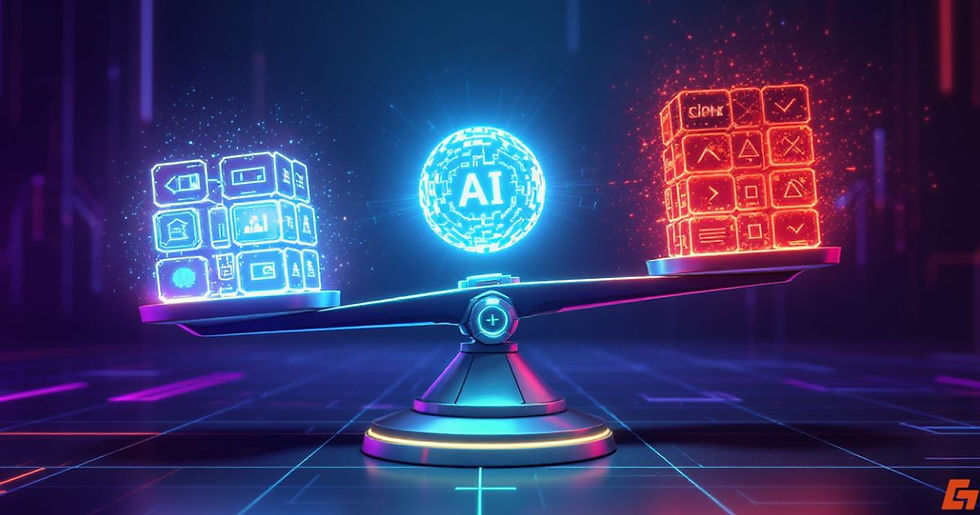Explainable AI Explained: Clarity for High-Stakes Decisions
- 1 day ago
- 7 min read

If an AI system rejects your loan, diagnoses you with an illness, or decides you’re unfit for a job, shouldn’t you have the right to know why? Blind trust in algorithms can be as risky as bad data itself.
Explainable AI is artificial intelligence designed to make its decisions and reasoning understandable to humans, ensuring transparency, accountability, and trust in automated systems.
As AI increasingly shapes healthcare, finance, and even justice systems, the need for clarity is no longer optional, it’s essential. Without explainable AI, we’re left guessing whether a model is accurate, fair, or biased. Understanding its logic isn’t just good practice, it’s becoming a legal and ethical necessity.
What You Will Learn in This Article
What Is Explainable AI and How Does It Work?
At its simplest, explainable AI refers to artificial intelligence systems that can clearly show how and why they arrived at a particular decision.

Instead of being a mysterious “black box” that spits out answers without context, an explainable model lays its reasoning on the table, step by step, or at least in a way humans can follow.
Why Black Box Models Fall Short
In traditional black box models, like deep neural networks, the internal logic is so complex that even the developers might not fully understand why the model gave a certain output.
This lack of transparency isn’t just a technical inconvenience; in sectors like healthcare, finance, or law, it can be a deal-breaker. Imagine a patient being denied a treatment plan or a borrower being refused a loan with no explanation. In those contexts, explainable AI isn’t optional, it’s a necessity.
Building the Bridge Between AI and Human Trust
The core idea is that people, whether they’re doctors, regulators, or end users, should be able to understand, question, and even challenge an AI’s reasoning.
When done right, explainability bridges the gap between cutting-edge algorithms and the human trust needed to put them into action.
Why Explainability in AI Can’t Be Ignored
The buzz around explainable AI isn’t just about satisfying curiosity, it’s about enabling real trust.

People tend to believe in what they understand, and when it comes to AI, that’s doubly true. If a system’s reasoning is a total mystery, users are more likely to treat its output with skepticism, or ignore it entirely.
Accountability in High-Stakes Decisions
There’s also the matter of accountability. In high-stakes environments like medicine, law enforcement, or hiring, decisions can affect someone’s health, freedom, or livelihood.
Without explainable AI, it’s impossible to pinpoint whether a decision was fair, biased, or simply wrong.
Debugging and Staying Compliant
From a developer’s perspective, explainability is invaluable for debugging. When you can see why a model misclassified a tumor or wrongly flagged a transaction as fraudulent, you can fix the problem faster.
And let’s not forget compliance, laws and regulations in places like the EU (think GDPR) often require that automated decisions be explainable. That’s not just a suggestion; it’s a legal demand.
How We Pull Back the Curtain on AI Decisions
Making AI systems interpretable isn’t a one-size-fits-all process. Sometimes, the path to explainable AI starts with building inherently transparent models, like decision trees or linear regression, where the logic is easy to trace.

This approach is straightforward but can limit performance in complex tasks.
Post-Hoc Techniques for Complex Models
Other times, we lean on post-hoc techniques, methods applied after the model is trained to interpret its behavior.
LIME: Local, Human-Friendly Insights
Tools like LIME (Local Interpretable Model-agnostic Explanations) help break down predictions into understandable pieces, offering a local view of how the model behaves for a specific case.
SHAP: A Global Look at Model Behavior
SHAP (SHapley Additive exPlanations) uses game theory to assign importance scores to each feature, giving a more comprehensive view of how inputs affect outputs. These tools don’t rewrite the model; they just give us a window into how it’s thinking.
The Power of Visualization
Visualization also plays a huge role. In computer vision, heatmaps can show which parts of an image influenced a decision. In machine learning for finance, feature importance charts can highlight the factors that most affected a credit score.
Together, these techniques help turn AI’s internal logic from an impenetrable fog into something closer to daylight.
The Tug-of-War Between AI Accuracy and Clarity
Here’s the tricky part: the more complex a model gets, the harder it often is to explain. Deep neural networks, for instance, can outperform simpler models in detecting cancerous cells or predicting market movements, but their internal decision-making is notoriously opaque.

The Classic Trade-Off in Explainable AI
With explainable AI, there’s often a trade-off between raw accuracy and interpretability. A decision tree might be easy to follow, but it might miss subtle patterns that a more advanced model would catch.
On the other hand, that complex model might make the correct call for reasons even its creators can’t fully articulate.
When This Trade-Off Really Matters
This isn’t just academic theory, it has real consequences. In cancer detection, a slightly more accurate but less explainable model might lead to faster diagnoses, but doctors could be reluctant to trust it without understanding its reasoning.
In finance, a loan approval system that can’t justify its decisions risks both legal trouble and reputational damage. Balancing these two forces, clarity and capability, is one of the ongoing challenges in AI development.
Where Explainable AI Becomes Non-Negotiable

Healthcare: Trusting the ‘Why’ Behind a Diagnosis
Some industries can live with a little mystery in their algorithms. Others can’t. In healthcare, knowing why an AI suggested a particular treatment is just as important as the recommendation itself.
A doctor needs to verify that the reasoning aligns with established medical knowledge and that it isn’t based on irrelevant or biased data.
Finance: Transparency as a Legal Requirement
In finance, transparency isn’t optional. Credit scoring models that fail to explain their logic can’t comply with regulations like the Fair Credit Reporting Act in the U.S.
Explainable AI helps lenders show applicants which factors impacted their creditworthiness, making the process fairer and more accountable.
Hiring: Keeping Bias in Check
Hiring is another hot zone. Automated resume screening can be efficient, but without explainability, it’s impossible to ensure the system isn’t unintentionally filtering out qualified candidates due to bias.
Autonomous Vehicles: Understanding Split-Second Decisions
In autonomous vehicles, explainability plays a role after the fact, helping engineers understand why a car made a particular maneuver, especially if it resulted in an accident or near miss.
The Real-World Hurdles of Making AI Explainable
Of course, making AI transparent isn’t as easy as flipping a switch. High-dimensional models like convolutional neural networks or large language models process massive amounts of data across layers of abstract features, explaining them in plain language is a huge technical challenge.

The Danger of Oversimplifying AI Reasoning
There’s also the risk of oversimplification. In trying to make an explanation “human-friendly,” we might strip away important details, creating a false sense of understanding.
It’s like summarizing a 500-page legal case into one sentence, you might get the gist, but you’ll miss critical nuances.
When an Explanation Misses the Mark
And not every explanation is useful. Developers can generate complex graphs or probability tables, but if the audience is a regulator or a customer, that data may need to be translated into actionable insights.
Explainable AI isn’t just about transparency, it’s about delivering the right level of clarity for the right audience, without distorting the truth.
What’s Next for Explainable AI?
The road ahead for explainable AI is looking both promising and demanding. On the research side, there’s growing interest in hybrid models, systems that combine the raw predictive power of complex algorithms with built-in interpretability layers.

This way, you get high accuracy without entirely sacrificing clarity.
Explainability in Everyday AI Tools
We’re also starting to see explainability baked into everyday tools. Google’s AI summaries in search results, for example, already show glimpses of how information is gathered and prioritized.
In customer service bots, developers are experimenting with ways to let users “ask” the AI why it gave a certain answer, turning explanations into interactive conversations.
Regulation Will Push Transparency Forward
Regulation is another driver. Governments and industry groups are pushing harder for transparency in AI, particularly in high-impact sectors.
The EU’s upcoming AI Act, for instance, is expected to impose stricter requirements on explainability, making it a legal necessity rather than a nice-to-have.
Over time, we might see explainable AI become the default expectation, not just in healthcare and finance, but in any domain where algorithms influence decisions that matter.
Why Every AI Decision Deserves an Answer
We began with the question: if an AI system rejects your loan, diagnoses you with an illness, or decides you’re unfit for a job, shouldn’t you know why? Throughout this article, we’ve seen how explainable AI can provide those answers, boosting trust, ensuring accountability, and keeping systems fair and transparent.
When algorithms influence life-changing outcomes, understanding their reasoning isn’t just a safeguard, it’s the foundation of ethical, responsible technology. Clear explanations turn AI from an opaque decision-maker into a tool we can question, refine, and trust.
If you’re building or deploying AI, consider how every decision your system makes could be explained to the people it affects. And as a user, the next time an algorithm makes a call about you, will you simply accept it, or will you ask to see the reasoning behind it?



Comments